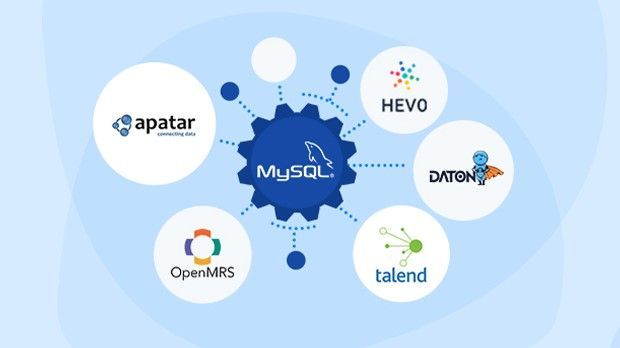
Is MySQL Good for Big Data?

Is MySQL Good for Big Data?
MySQL is one of the most popular open-source relational database management systems (RDBMS) designed for fast transactions, making MySQL unsuited as a tool for heavy data analysis. Performing big data analysis and compute-intensive business intelligence workflows across large datasets is better suited for a cloud-based data warehouse like Snowflake, BigQuery or Redshift.
Is MySQL a Data Warehouse?
MySQL is
not a data warehouse but is rather more frequently used as one of many data sources to extract
MySQL data out of, or to
load data into.
Using MySQL data pipelines, data analysts can extract data MySQL data out of a database into a data warehouse for analysis.
Data analysts can subsequently load data transformed in data warehouse into a MySQL production schema, to be consumed by APIs or utilized in the user interfaces of apps. This is a popular use case for SaaS apps that feature reporting or analytics for their users.
What are the Advantages of MySQL ETL tools?
The advantage you can configure your own Python-based data integrations by following tutorials, but this can be overly complex and not very user-friendly, especially when dealing with multiple data flows and data pipelines.
Advantages of MySQL ETL tools are outsourced complexity and accelerated time-to-value.
A good MySQL ETL process is easy-to-automate and user-friendly.
Below are the top ETL tools with pricing so you can choose one that works best for your organization's use cases.
Is MySQL an ETL tool?
MySQL is not an ETL tool and does not have built-in ETL connectors.
Thus, in order to extract MySQL data as XML or CSV files, or load data into a data warehouse for data analysis, you'll need an ETL tool.
List of MySQL ETL Tools
- Stitch
- FiveTran
- Blendo
- Airbyte
- Integrate.io
- Pentaho
- Hevo Data
- Talend Open Studio
- Amazon AWS Glue
- Azure Data Factory
- Google Dataflow
Top 4 MySQL ETL tools
- Stitch
Stitch is an ETL tool that's part of the Talend ecosystem. It supports data transformations with Python, Java, SQL, or its no-code GUI. Stitch also supports change data capture and data replication.
Key features
- Support for over 130 data sources.
- Built-in integrations with Talend suite of data tools.
- Compatible with scripted and GUI-based data transformations.
- Automations for monitoring and notifications.
Disadvantages
- Complex data transformations are not as well supported as on some other platforms.
- On-premise deployments not available.
- Limits on the number of data sources and destinations.
2. Fivetran
Fivetran is a popular ETL tool with 160+ supported data sources.
It can load data to MySQL and Postgresql databases hosted locally and on Amazon RDS, Amazon Aurora, Google Cloud, and Microsoft Azure.
Key features
- Native warehouse transformations that work well even with complex data.
- Support for change data capture for data replication jobs.
- Real-time or near real-time data synchronization.
Disadvantages
- Higher-priced tool than many competitors.
- Consumption-based pricing models can be hard to predict month-to-month.
- Only supports ELT workloads, not ETL.
3. Blendo
Blendo is a data integration tool with several automations to speed up the creation of ETL pipelines. It has scripts and predefined data models.
Key features
- Supports 45+ data sources.
- No-code platform that's ideal for nontechnical teams.
- Built-in monitoring and alert features.
Disadvantages
- Not as many data connectors as other MySQL ETL tools.
- Limited data transformation functionality.
- Teams can't create new data connectors on their own.
4. Airbyte
Airbyte is an ETL platform that supports MySQL as both a data source and a destination.
You can deploy Airbyte's open-source version yourself or use its paid cloud plan.
Key features
- Support for 170+ data connectors (not all connectors available on cloud plan).
- Large open-source community.
- Warehouse-native data transformations.
Disadvantages
- Consumption-based pricing model, which can be hard to predict from one month to the next.
- Cloud plan is missing some data integrations.
Runner-up MySQL ETL tools
Nearly every ETL tool will let you export data out of MySQL databases, but not all will help you import it. Here are a few of our runner-up choices for loading data into MySQL.
Pentaho
Pentaho is a platform owned by Hitachi Vantara that lets you import data into MySQL. It also includes business intelligence features to find insights using the same platform.
Integrate.io
Integrate is a no-code platform that supports 200+ data sources. It has pre-built templates to speed up creating new data flows.
Hevo Data
Hevo is a no-code ETL tool that supports 150+ data sources and ETL, ELT, and Reverse ETL workflows. It supports real-time data loading, replications, and transformations.
Talend Open Studio
Talend Open Studio is a free to download tool compatible with MySQL and other RDBMS like Microsoft SQL Server. It is free under the open source Apache license.
Amazon AWS Glue
AWS Glue is a serverless integration service that allows for ETL workflows between Amazon services like S3 and RedShift.
Azure Data Factor
Azure Data Factory is a managed, serverless data integration service best for transitioning from on-premise SQL Server and SSIS workflows to the cloud. Azure Data Factory has connectors to Google BigQuery and Amazon RedShift.
Google Dataflow
Google Dataflow allows for serverless streaming and batch data processing. Dataflow comes with $300 in free credits.